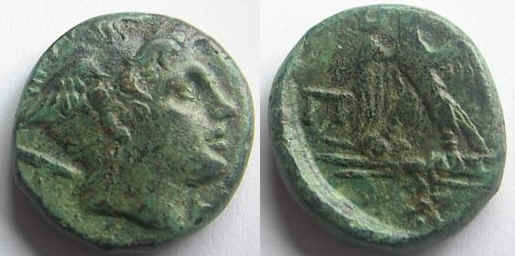
GBP 13,50 (EUR 19,57), 10-apr-05, ebay, coins2artefacts
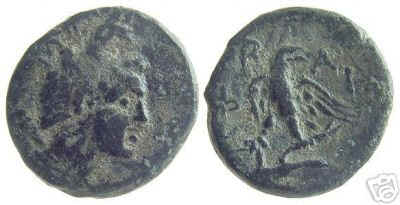
Perseus, Macedon, 178-168 BC, bronze of 19.5 mm, 6.18 grams.
Obverse: Bust of Perseus to right.
Reverse: Eagle.
Reference: cf. Copenhagen 1275.
US $33,52 (EUR 28,45), 11-okt-05, ebay, amphoracoins
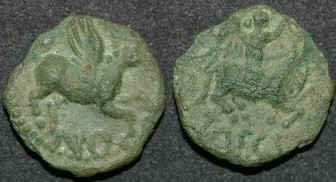
S343, BMC 1913-19.
FOUND NORFOLK, ENGLAND.
GBP 28,00 (EUR 41,46), 13-nov-05, ebay, hiddenhistory
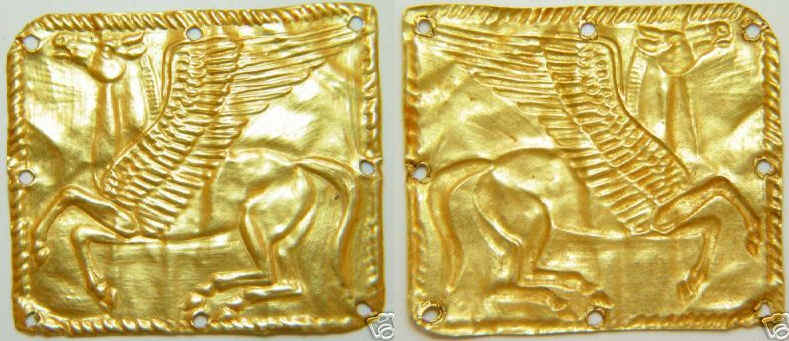
US $6.500,00 (EUR 5.368,79)
Nu kopen prijs: US $6.852,00, niet verkocht, 08-mrt-06, ebay,
eticoins
SCYTHIAN GOLD PLAQUE 4 th Cent. BC The sheet-gold plaque hammered over a matrix,
depicting PEGASUS ,mythological winged horse.
Problem free ornamen ,Choice egz. 51 mm by 46 mm
Pegasus is a mythological creature known from ancient Greece. It was said to have been a
winged horse. Legends say that Pegasus originated from Medusa, when she was killed by
Presses. When her blood seeped through the ground, Pegasus emerged from the blood.
Several stories say that Bellerophon, the son of Poseidon, received a golden bridle as a
gift from the god of wisdom, Athena. With the bridle he was able to catch and tame
Pegasus. Other stories say that Athena caught and tamed Pegasus herself and gave him to
the Muses. Yet another story says that when he emerged from the blood that he flew away
from earth and lived with Zeus in the heavens. While riding him, Bellerophon he was
unbeatable. He rode Pegasus in the defeat of the Chimera, a man-eating monster, which was
a task that many had tried and failed. Although a great pair, Belerophon was thrown from
Pegasus by Zeus when he tried to ride him up Mount Olympus, and was crippled.
One story suggests that Athena learned of the incident, and gave Pegasus to Zeus. Pegasus
then became Zeus’, and had a home on Mount Olympus. Many stories say that he carries
Zeus’s lightning bolts for him. When he wants one he calls for Pegasus and he brings
one to him. Another story said that Zeus then gave him to his daughters, the Muses, whose
sacred spring, the Hippocrene, was made by Pegasus. It is said that because Zeus liked
Pegasus so much he named a constellation after him so that he would always have a home in
the heavens.
There are several pieces of literature, such as poetry, and art that portray Pegasus. Each
piece is slightly different from each other as you can tell from my report. Pegasus is
used in tie with many Gods and Goddesses. He helps in many ways and is a well-known
character from Greek Mythology
Pegasus is the Muses’ winged horse. The name Pegasus is from the Greek word for
spring, or water. When Persens cut off the head of Medusa, Pegasus and Chrysaor, the
fierce warrior, were born from her blood spilled on the ground. Athena then tamed Pegasus
and gave him to the nine Muses to raise.
Pegasus played a major role in the life of Bellerophon. Bellerophon was ordered to kill
the monster, Chimaera. Without Pegasus Bellerophon knew it would be impossible to kill
Chimaera. Athena gave Bellerophon a golden bridle to tame Pegasus. With the help of
Pegasus, Bellerophon was able to fly above Chimaera, avoiding the flames, and kill the
monster. Bellerophon thought that with Pegasus, he could fly up to Mount Olympus to join
the Gods. Pegasus knew that Mount Olympus was no place for a mortal, so he threw
Bellerophon back down to earth. Bellerophon spent the rest of his life wondering around,
avoiding humans. Pegasus on the other hand was rewarded, by being put up in Zeus’s
stables with his finest horses.
Since Pegasus was the horse of the Muses, he was always ready to serve the poets. One myth
says that he was sold by a needy poet for money. When his new master tried to hook his
plow to Pegasus, the master found he was not fit to do the job. A little boy came up to
the master and asked him if he could try to ride Pegasus. Pegasus was mean toward the boy
at first, but as soon as he got on Pegasus’s back, Pegasus became nice, and flew the
boy toward heaven.
Pegasus was very helpful to the Muses. When he first came to Mount Helicon, he struck the
ground with his hoof, creating a stream of water. The Muses were so happy that they named
the spring, Hippocrene, which means horse’s fountain. Pegasus also formed the stream
Aganippe. The Muses treated the streams like sancuaries, and even built temples on them.
Pegasus was sort of a messenger for Zeus. When Zeus wanted thunder and lightning, he sent
Pegasus to get it for him. Zeus later made Pegasus a constellation. The constellation is
beside the milky way, and contains many galaxies.
Bibliography
Jessica D.
“Aganippe.” The Muses in Mythology. .2004. .2 Feb. 2004.
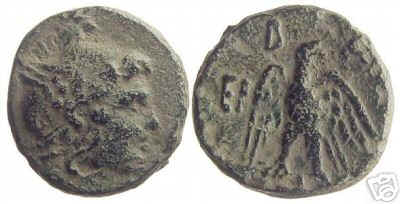
Perseus, Macedon, 178-168 BC, bronze of 16.6 mm, 4.55 grams.
Obverse: Bust of Perseus to right.
Reverse: Eagle.
Reference: cf. Copenhagen 1275.
This lot is accompanied by a photo-authenticity receipt signed by David Hendin, author of Guide to Biblical Coins.
US $18,26 (EUR 15,08), 28-feb-06, ebay, amphoracoins
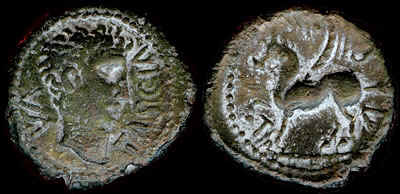
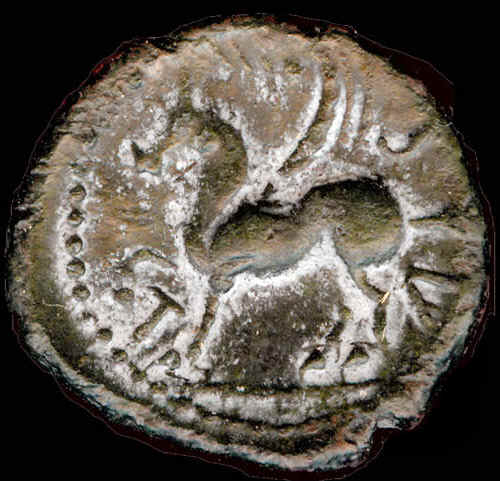
REVERSE: Pegasus left on exergual line, right foreleg raised, TAS around, beaded border
GRADE: aEF; 5.39 gm, 20 mm, possibly the nicest specimen extant
ATTRIBUTION: CCI 98-1997; VA 1818; BM 1684; Rudd 38 lot 57 Extremely Rare
COMMENT:
Double AE unit-- largest British Celtic AE; heavy specimen, full legend, dark green patina; 21 specimens known, 9 in museums
Evans, “Head probably of Augustes, Tasciovanus spelt with A instead of O” De Jersey: “This issue of Tasciovanus is the only known example of a British double bronze unit-- possibly an imitation of the Roman AS, an experiment that also occured amoung the Lexovii in Normandy in the post-Gallic war period. The rarity suggests it was not a popular experiment. This is one of the heaviest and clearest in the CCI and unusually have the full TAS inscription on the reverse, the S usu being off the flan. The head may be a portrait of Tasciovanus himself as Evans suggests.
Provenance: Found near Princes Risborough, Buckinghamshire, Grid Ref: SP 80-- 03--
US $1.000,00 (EUR 778,88), Nu kopen prijs: US $1.500,00, niet verkocht, 20-jun-06, ebay, kernunnos
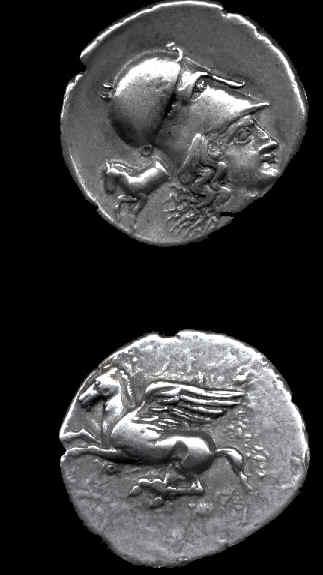 In Greek mythology, Pegasus (Pegasos) was a winged horse
that was the foal of Poseidon, in his role as horse-god, and the Gorgon Medusa.
Descriptions vary as to the winged stallion's birth and his brother the giant, Chrysaor;
some say that they sprang from Medusa's neck as Perseus beheaded her, a "higher"
birth, like the birth of Athena from the head of Zeus. Others says that they were born of
the earth as Medusa's blood spilled onto it, in which case Poseidon would not be their
sire. Minerva caught and tamed Pegasus, and presented him to the Muses. Hesiod connects
the name Pegasos with the word for "spring, well", pe-ge-; everywhere the winged
horse struck hoof to earth, an inspiring spring burst forth: one on the Muses' Mount
Helicon, the Hippocrene ("horse spring"), at the behest of Poseidon to prevent
the mountain swelling too much and another at Troezen. The actual etymology of the name is
most likely from Luwian pihassas "lightning", or pihassasas, a weather god (the
god of lightning). In Hesiod, Pegasos is still associated with this original significance
by carrying the thunderbolts for Zeus. Pegasus aided the hero Bellerophon, who is a double
in some way for Perseus, in his fight against both the Chimera and the Amazons. There are
varying tales as to how Bellerophon found Pegasus, some say that the hero found him
drinking at the Pierian spring and that Polyidus told Bellerophon how to find and tame
him, others that either Athena or Poseidon brought him to Bellerophon.
In Greek mythology, Pegasus (Pegasos) was a winged horse
that was the foal of Poseidon, in his role as horse-god, and the Gorgon Medusa.
Descriptions vary as to the winged stallion's birth and his brother the giant, Chrysaor;
some say that they sprang from Medusa's neck as Perseus beheaded her, a "higher"
birth, like the birth of Athena from the head of Zeus. Others says that they were born of
the earth as Medusa's blood spilled onto it, in which case Poseidon would not be their
sire. Minerva caught and tamed Pegasus, and presented him to the Muses. Hesiod connects
the name Pegasos with the word for "spring, well", pe-ge-; everywhere the winged
horse struck hoof to earth, an inspiring spring burst forth: one on the Muses' Mount
Helicon, the Hippocrene ("horse spring"), at the behest of Poseidon to prevent
the mountain swelling too much and another at Troezen. The actual etymology of the name is
most likely from Luwian pihassas "lightning", or pihassasas, a weather god (the
god of lightning). In Hesiod, Pegasos is still associated with this original significance
by carrying the thunderbolts for Zeus. Pegasus aided the hero Bellerophon, who is a double
in some way for Perseus, in his fight against both the Chimera and the Amazons. There are
varying tales as to how Bellerophon found Pegasus, some say that the hero found him
drinking at the Pierian spring and that Polyidus told Bellerophon how to find and tame
him, others that either Athena or Poseidon brought him to Bellerophon.In popular culture, the myth of Pegasus has been incorrectly associated with various heroic myths other than Bellerophon. The movie Clash of the Titans blends the myths of Bellerophon and Perseus into one myth where Perseus becomes the original tamer of Pegasus. Similarly, in the Disney adaptation of the Hercules legend, Pegasus is depicted as a childhood pet of Hercules.
Following Pegasus (or Pegasos) ancient coins were minted in Corinth Greece and many of her colonies, during the time period of 405 to 307 BC . The coin:
AKARNANIA, Anaktorion. Circa 345-300 BC. AR Stater. Pegasos flying left / Helmeted head of Athena left AV;
weight: approx 8.3 grams
diameter: 21mm
US $325,00 (EUR 253,13), Nu kopen prijs:US $375,00, niet verkocht, 25-jul-06, ebay, shipwreckcoins
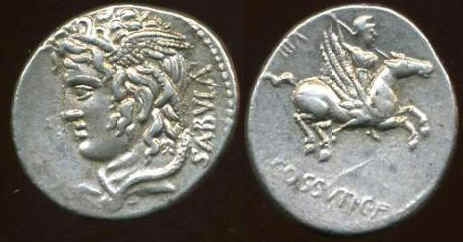
US $899,99 (EUR 691,02) Nu kopen prijs: US $1.200,99, niet verkocht, 25-jan-07, ebay, chasenholdings